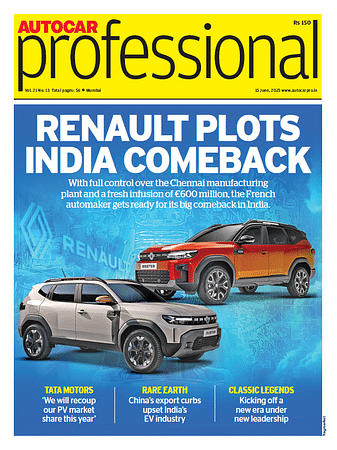AM/NS: Getting Ready for Green Steel
Players like ArcelorMittal Nippon Steel are getting ready for introduction of the India's new Green Steel rating scheme in April 2026.
India’s push to cut industrial emissions is gaining traction with the rollout of a first-of-its-kind Green Steel Taxonomy—ushering in a new era for steel procurement in sectors like automotive, where emissions accountability is becoming critical. ArcelorMittal Nippon Steel India (AM/NS India), one of the country’s leading integrated steelmakers, is preparing to be the first in line for certification under the new system, which classifies steel based on its carbon footprint. As climate regulations tighten and sustainability climbs the corporate agenda, the Indian government’s newly
introduced Green Steel Taxonomy is poised to be a game- changer. Finalized in December 2024, and likely to take effect in April 2026, the framework will rate steelmakers based on the carbon intensity of their production—setting a standard in an industry long criticized for its emissions. For automotive companies, the implications are significant.
As they transition to electric vehicles and face rising scrutiny over Scope 3 emissions—the indirect footprint of their supply chains—steel sourcing is becoming a strategic concern. Flat steel, a core material for auto manufacturing, must now align not only with performance requirements, but also with environmental expectations. ArcelorMittal Nippon Steel India, a joint venture between ArcelorMittal and Nippon Steel, believes it’s ready and announced that it is on track to become the country's first integrated steel producer to earn at least a three-star certification under the new framework.
“This landmark initiative provides a clear roadmap for the steel industry to transition towards sustainable practices,” said Dilip Oommen, CEO of AM/NS India. The taxonomy is managed by the National Institute of Secondary Steel Technology (NISST), which oversees the certification process and star ratings. Green steel, as defined in this context, refers to production with emissions below the 2.2 tCO2 threshold. Top-rated producers—those emitting less than 1.6—can earn a five-star rating.
AM/NS India achieved a CO2 intensity of 2.17 tCO2/tcs ( tons of carbon dioxide equivalent per tonne of crude steel) in FY 23–– 14% lower than the national average and aims to achieve 20% reduction in carbon emissions intensity by 2030 to 1.8 tCO2/tcs from the 2021 baseline. The company has already reduced its carbon emissions intensity by over 35% since 2015. Currently, 65% of AM/NS India's steel capacity is derived from the Direct Reduced Iron (DRI) route that uses natural gas. This process has a low carbon footprint. The ongoing expansion incorporates state-of -the-art technologies that focus on lowering carbon emissions.
Green Steel 2027
It’s not just about steel—AM/NS India is also building out the infrastructure to back its green ambitions. In Andhra Pradesh, it is developing a renewable energy facility with pumped hydro storage. It’s also expanding its scrap processing capabilities to raise the recycled content in its products. By 2027, the company expects 70% of its production to be classified as green steel. “By 2027, the company expects 70% of its overall production to be green,” said Ranjan Dhar, Director and Vice President of Sales and Marketing at AM/NS India.
“The idea is not just for our company to come out with green steel. But it is also making the product of our customers green.” Nowhere is that more relevant than in the automotive industry. Vehicle makers currently account for 17–18% of AM/NS India’s revenue, and that number could double in coming years. To meet demand, the company is ramping up capacity—from 9–10 million tons per year today to 15.6 million tons by 2027.
Two new production lines, tailored for automotive-grade steel, are expected to be operational by 2025. The company sees the auto sector as central to its expansion strategy. Green steel, however, is still a loosely defined term. Globally, there’s no single standard. Most definitions center on emissions intensity and production methods—such as electric arc furnaces or hydrogen-based reduction using recycled materials.
In India, where adoption is nascent, automakers still largely focus on high-strength steels for weight reduction, which improves fuel efficiency and EV range but doesn’t necessarily mean the steel itself is green. “While the world is grappling with many things, India has clarity (on green steel definition and parameters),” said a top company official.
Green Steel Surge
Yet the movement is gaining pace. Major steel producers like Tata Steel and JSW Steel are developing low-carbon production strategies. Tata is exploring nuclear-powered steelmaking and ramping up renewables. JSW has targeted Europe with its green steel plans, aiming to meet the EU’s strict Carbon Border Adjustment Mechanism (CBAM) regulation in addition to catering to the domestic markets. In the broader market, demand for flat steel in auto manufacturing is already at 7.8 million tonnes annually and growing 6–7% each year. Meanwhile, the Indian hot-rolled and cold-rolled steel market is projected to reach $270.5 billion by 2030, up from $171.1 billion in 2024.
Road Ahead
With clear government definitions and rising global demand, industrial giants like AM/NS India, Tata Steel and JSW are taking the lead and laying the foundations for a supply chain transformation. For automakers, adapting to these new standards may be complex—but the long-term payoff lies in building vehicles that are genuinely greener from the ground up.
RELATED ARTICLES
Hero vs Honda: In Numbers
A Comparative Study of Honda Motorcycle & Scooter India and Hero MotoCorp.
Mahindra and Lightweighting: Solid Steel To Nimble Aluminum
Stricter emission regulations and rising fuel efficiency targets are driving a fundamental transformation in powertrain ...
A Veteran's Guide to Range-Hacking EVs
Tata Motors' Anand Kulkarni shares various ways in which the range of an EV can be enhanced without increasing the size ...





 By Shahkar Abidi
By Shahkar Abidi
 29 Jun 2025
29 Jun 2025
 567 Views
567 Views





 Autocar Professional Bureau
Autocar Professional Bureau


 Ketan Thakkar
Ketan Thakkar


